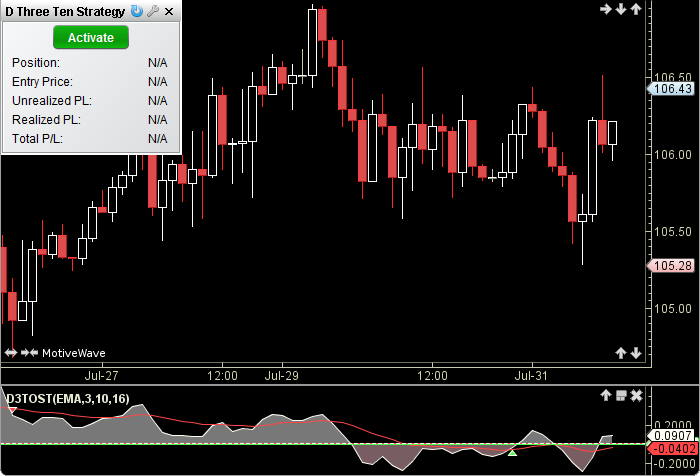D Three Ten Strategy
The D Three Ten Strategy is based on the D Three Ten Oscillator study by Bill Mars. Signals generated in the study are used to trigger automatic trades. This automated trading strategy was created to demonstrate the mechanics of an automatic trade and is not intended for actual use. A more comprehensive strategy that may include multiple studies, margins and stops could be developed. This strategy definition is further expressed in the code given in the calculation below.
See D Three Ten Oscillator

How To Trade using the automatic D Three Ten Strategy
Examine the details of the D Three Ten Oscillator study (see link above). Use the strategy optimiser and back testing to aid in the selection of the period lengths and guide values. Open the strategy and configure the inputs for General, Display, Trading Options, Panel and Signals. Activate the strategy.
How To Access in MotiveWave
Go to the top menu, choose Strategies>General>D Three Ten Strategy
or go to the top menu, choose Add Study, start typing in this study name until you see it appear in the list, click on the study name, click OK.
Important Disclaimer: The information provided on this page is strictly for informational purposes and is not to be construed as advice or solicitation to buy or sell any security. Please see our Risk Disclosure and Performance Disclaimer Statement.
Calculation
public void onActivate(OrderContext ctx)
if (getSettings().isEnterOnActivate())
DataSeries series = ctx.getDataContext().getDataSeries();
int ind = series.isLastBarComplete() ? series.size()-1 : series.size()-2;
Boolean buy = series.getBoolean(ind, Signals.BUY);
Boolean sell = series.getBoolean(ind, Signals.SELL);
if (buy == null OR sell == null) return;
int tradeLots = getSettings().getTradeLots();
int qty = tradeLots * ctx.getInstrument().getDefaultQuantity();
switch(getSettings().getPositionType())
case LONG: //Only Long Positions are allowed
if (buy) ctx.buy(qty);
break;
case SHORT: //Only Short Positions are allowed.
if (sell) ctx.sell(qty);
break;
default: //Both Long and Short Positions Allowed
if (buy) ctx.buy(qty);
else ctx.sell(qty);
end
end
endMethod
public void onSignal(OrderContext ctx, Object signal)
Instrument instr = ctx.getInstrument();
int position = ctx.getPosition();
int tradeLots = getSettings().getTradeLots();
int qty = tradeLots * instr.getDefaultQuantity();
switch(getSettings().getPositionType())
case LONG: //Only Long Positions are allowed.
if (position == 0 AND signal == Signals.BUY)
ctx.buy(qty); //Open Long Position
end
if (position moreThan 0 AND signal == Signals.SELL)
ctx.sell(qty); //Close Long Position
end
break;
case SHORT: //Only Short Positions are allowed.
if (position == 0 AND signal == Signals.SELL)
ctx.sell(qty); //Open Short Position
end
if (position lessThan 0 AND signal == Signals.BUY)
ctx.buy(qty); //Close Short Position
end
break;
default: //Both Long and Short Positions Allowed
//allow for 2 successive transactions
//qty += Math.abs(position);
if (position lessOrEqual 0 AND signal == Signals.BUY)
ctx.buy(qty); //Open Long Position
end
if (position moreOrEqual 0 AND signal == Signals.SELL)
ctx.sell(qty); //Open Short Position
end
end
endMethod
